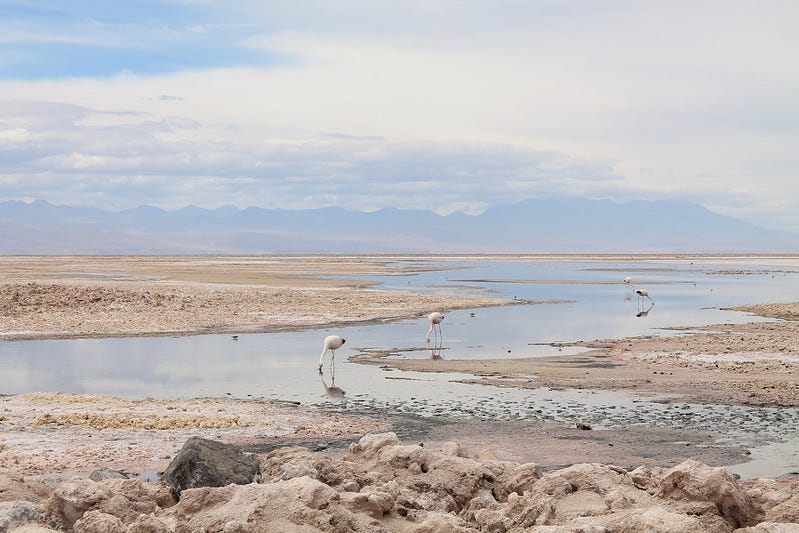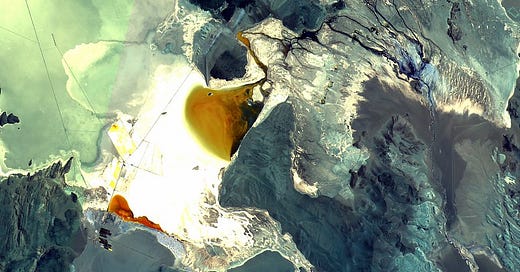The journey to responsibly mined lithium
Lithium operations in Chile's salt flats scored high against a tough standard. What does this tell us about achieving sustainable batteries?
Climate technologies require enormous amounts of metal. I’m Ian Morse, and this is Green Rocks, a newsletter that doesn’t want dirty mining to ruin clean energy.
News round-up coming next week! In the meantime, today begins a UN Environment Assembly bringing governments together to consult on sustainable mineral governance. The UN set up this meeting last year in recognition of the pressure to expand mining in the name of climate action. Advocates have called attention to the need to ensure that communities have the right to give their free, prior and informed consent on extraction projects.
And in that spirit, a story from South America’s Lithium Triangle:
It’s an understatement to say lithium operations in Chile’s salt flats have made the rounds in the media. Albemarle, an American company, and SQM, a Chilean company, pump slimy brine from beneath the Salar de Atacama into hundreds of ponds and let it roast in the sun for months. The water evaporates, and concentrated lithium salts are left and sent elsewhere for processing. To some, dwindling water resources spotlight the impacts on Indigenous communities and flamingos that surround the flat. Scientists continue to study the flats: how water circulates, how life lives in extreme conditions, and how people are feeling the impacts.
This summer, Albemarle became the first lithium miner to audit its operations against what is considered the top mining standard — a series of tests to evaluate whether a mine is upholding best practices. Yesterday, SQM became the second. The standard is from the Initiative for Responsible Mining Assurance, or IRMA, a group of researchers and technical experts encouraging mines to be “responsible.”
Albemarle scored an IRMA 50 — meaning they checked at least 50% of the boxes in four categories. SQM scored an IRMA 75. Both these scores fulfill 40 critical requirements for which there is zero tolerance. They may not sound like a high scores; it’s indicative of how tough it is to create a “responsible mine.”
For Aimee Boulanger, Executive Director of IRMA, these reports demonstrate “that mines supplying materials essential to the renewable energy transition can now point to transparent, independent evaluations of their environmental and social performance.” The reports, totaling more than 250 pages, are available online.
Both industry and civil society members have held up IRMA as the toughest standard around — and one that weaves the demands of civil society and affected communities into audits. Few mines have signed up for its independent assessments. Yet some researchers and activists worry that IRMA may not be able to address systemic problems, and that the audits may end up making problems worse for communities.
“We don’t think it’s a valid method or institution to assess mining operations in the salt flats, especially when it’s used by mining companies as an argument to claim they’re “sustainable” when they’re not,” says Ramón Balcázar, of the Plurinational Observatory of Andean Salt Flats, and who has for years been part of IRMA’s community engagement. (IRMA says they don’t use the word “sustainable.”)

IRMA’s standard is atypical for the industry. The organization says civil society, communities and organized labor share equal governance over the standard with the private sector. Where consensus isn’t achieved, they vote — unless a member is “fundamentally opposed” to a decision. IRMA also doesn’t conduct the audit, but rather trains independent certification bodies to do so.
Achieving some score on IRMA’s assessment isn’t a last step. Boulanger says it’s an ongoing commitment to transparency, especially with local communities, researchers and activists.
“We actually have a set of colleagues who are down carrying hand-printed sections of the audit report around in Chile right now to encourage their neighbors to read it,” says Boulanger. “If the results don’t fully reflect the experience of communities, Indigenous rights holders or other affected groups, we want to hear from them.”
A central question with an audit like this is how companies intend to use it. IRMA maintains that audits don’t yield “certifications” nor declare when a mine is “responsible.” (However, its Spanish press releases use the word “certificación.”) Boulanger says the audit is only meant to provide information to boost accountability, transparency, and dialogue.
Balcázar isn’t convinced. There may not be much stopping a company using its IRMA score to persuade investors to open up green funds, or partners to sign purchase agreements. Considering the makers of EVs and batteries are intent on demonstrating a clean supply chain, an IRMA score may play a role. (Albemarle didn’t respond to questions about how it intends to use its audit.)
Activists in Argentina in the last 12 months have raised concerns about another IRMA audit taking place. The audit, they wrote, doesn’t address their contention that lithium mining is incompatible with traditional livelihoods and constitutional rights. A global mining activist organization then outlined 10 reasons to oppose certification schemes, while not naming IRMA specifically.

There are a few structural qualities of audits that are worth considering.
As a voluntary initiative, IRMA doesn’t have much power to change practices. Rather, such standards rely on peer pressure to push companies in the right direction. The power to sanction typically lies with governments, and IRMA acknowledges that its work will never replace the importance of law enforcement and regulation.
However, some governments have begun adopting industry standards as markers of evaluating responsible practices. The European Commission proposed as much in its Critical Raw Materials Act, noting that IRMA is one of many certification schemes that have been used there. Certification schemes also risk privatizing the process for resolving grievances lodged by communities, with uncertain requirements for companies to respond.
Industry standards are typically built to address qualities of a single operation. However, the impacts from mines may accumulate when there’s more than one in an area. In the Atacama Salt Flat, for instance, the circulation of water throughout the ecosystem may not be impacted by a few brine pumps. It’s more difficult to attribute the impacts of dozens of pumps across the system, however.
Sharing equal governance is complicated. Local communities depend on ecosystems, watersheds and clean air for life, whereas companies that can pay for a legal defense are typically beholden to law enforcement, which can be weak, and shareholders, who are often a continent away. Giving companies as much power as communities, though, removes the option to avoid mining altogether (which some communities in South America have opted to do).
This is important when it’s difficult to account for history and systemic issues. In Chile, mining is built on laws that were enacted during a military dictatorship that privatized almost the entire natural landscape and let the private sector distribute resources. Both audits note that the government did not acquire free, prior, and informed consent (FPIC) from local communities before SQM and Albemarle (and their predecessors) obtained mineral rights.
And in the end, Balcázar says that the integrity of an audit is jeopardized by money changing hands. “It’s not us [paying for these schemes], it’s not the indigenous communities and it’s not the ecosystems. It’s the corporations interested in greenwashing their unsustainable and corrupted operations in our countries and territories.”
Boulanger responded to some of these concerns:
Indeed we're aware of the criticisms from civil society and we respect the truth that mining is causing harm to lands and the people reliant thereon. We also understand and respect concern that voluntary initiatives could be seen to greenwash and give permission to continue extraction, when our intention is instead to provide a substantive way to increase access to information on impacts and a market push for improved practices.
Even with best-case scenarios for circular sourcing and policies to encourage it, mining is forecast to increase. Yet industrial-scale mining is inherently, inescapably destructive. An IRMA audit gives an unprecedented window into how and how well a mine attempts to reduce that harm. And by providing that window the audit also provides additional incentive for a mine to improve those attempts.






